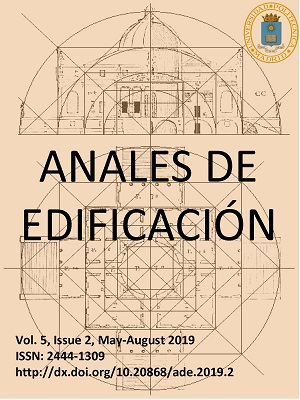La segunda vida de los residuos de construcción. Propuesta para reutilizar como agregado árido reciclado y residuos de material aislante = The second life of construction waste. Proposal to reuse recycled fine aggregate and residues of insulating materials
DOI:
https://doi.org/10.20868/ade.2019.4039Palabras clave:
Relleno reciclado, residuos de hormigón, productos de cal de arena modificados, residuos de material de aislamiento, lana de la roca, fibra de vidrio, residuos de construcción y demolición, Recycled filler, concrete rubble, modified sand lime products, insulating waste, rock wool, fiberglass, construction and demolition wasteResumen
El artículo presenta los resultados de una investigación propia que confirma la posibilidad de reutilizar materiales de desecho: la fracción fina del hormigón que se recicla como sustituto de arena, residuos de material aislante (lana de roca y fibra de vidrio) y arena reciclada. Se realizaron ensayos de Resistencia a compresión y flexión, absorción de agua por capilaridad y dureza superficial. Los resultados muestran que todos los materiales descritos podrían servir como solución aceptable para la reducción del uso de recursos naturales - arena natural (por ejemplo) o, como relleno. La reutilización de residuos en el mundo debe llevarse a cabo debido a la carencia de recursos naturales
Abstract
The paper presents the results of own research confirming the possibility of reusing a waste material: fine fraction from concrete recycling as a filler in sand lime products and residues of insulating materials (rockwool and fiberglass) and recycled sand using as a insulating materials. The compressive strength, bending, water absorption, surface hardness and structural research were carried out. The results show that the all of describing materials could be acceptable solution to reduce natural resources - natural sand (for example) or be a filler. Reuse of waste materials to new composites is expected in this world because of lack of natural resources.
Descargas
Referencias
Behera M., Bhattacharyya S.K., Minocha A.K., Deoliya R., Maiti S. (2014). Recycled aggregate from C&D waste & its use in concrete – A breakthrough towards sustainability in construction sector: A review. Construction and Building Materials,vol. 68, 501–516
Bołtryk, M., Kalinowska, K. (2016). The cement composites with modified recycled addition,
Budownictwo i Inżynieria Środowiska, vol.7 nr 1, s.7-10
Bołtryk M., Kalinowska, K. (2017). Frakcja drobna z recyklingu betonu jako aktywny wypełniacz wyrobów wapienno-piaskowych ,Materiały budowlane, s.52-54.
Bołtryk, M., Pawluczuk, E., Kalinowska, K., Patent (PAT.229887), Sposób oddzielania stwardniałej zaprawy cementowej od kruszyw grubego i urządzenie do stosowania tego sposobu.
Cheng, An, Wei, L. and Huang, R. (2011). “Application of Rock Wool Waste in Cement-Based Composites” Materials and Design 32(2): 636–42.
Ferrari G., Miyamoto M., Ferrari A. (2014). New sustainable technology for recycling returned concrete. Construction and Building Materials, vol. 67, 353–359.
Gastaldi D., Canonico F., Capelli J., Buzzi L., Boccaleri E., Irico S. (2015). An investigation on the recycling of hydrated cement from concrete demolition waste. Cement & ConcreteComposites, vol. 61, 29–35.
Gębarowski P., Łaskawiec K., Skorniewska M. (2015). Wpływ warunków autoklawizacji na właściwości tworzyw krzemianowych, Prace Instytutu Ceramiki i Materiałów Budowlanych, nr 20', s.23-33.
Pawluczuk, E., Kalinowska, K. (2015). Ocena zastosowania spoiwa z recyklingu do betonów drobnoziarnistych, Budownictwo i Inżynieria Środowiska, vol.6, nr 4, s.193-200.
Schoon J., Buysser K., Driessche I., Belie N. (2015). Fines extracted from recycled concrete as alternative raw material for Portland cement clinker production. Cement & Concrete Composites, vol. 58, 70–80.
Thomas C., Setién J., Polanco J.A., Alaejos P., Sánchez de Juan M. (2013). Durability of recycled aggregate concrete. Construction and Building Materials, vol. 40, 1054–1065.
Piña, Carolina et al. (2018). “Feasibility of the Use of Mineral Wool Fibres Recovered from CDW for the Reinforcement of Conglomerates by Study of Their Porosity.” Construction and Building Materials 191, 460–68.
Saiz, P, M Gonz, and F Fern. (2015). “Characterization and Influence of Fine Recycled Aggregates on Masonry Mortars Properties.” Materiales de construcción, 65(319), 1–10.
Krzywobłocka - Laurów R. (1998). Badania składu fazowego betonu. Instrukcja 357/98. Instytut Techniki Budowlanej, Warszawa 1998 r.
Väntsi, O., and T. Kärki. (2014). “Mineral Wool Waste in Europe: A Review of Mineral Wool Waste Quantity, Quality, and Current Recycling Methods.” Journal of Material Cycles and Waste Management. 62–72.
Zielenkiewicz W., Kamiński M. (2001). A conduction calorimeter for measuring the heat of cement hydration in the initial period. Journal of Thermal Analysis and Calorimetry 65, 335-340.
Descargas
Publicado
Número
Sección
Licencia
1. Los autores conservan los derechos de autor y garantizan a la revista el derecho de una Licencia Creative Commons Atribución - Nocomercial 4.0 Internacional que permite a otros compartir el trabajo con un reconocimiento de la autoría y uso no comercial.
2. Los autores pueden establecer por separado acuerdos adicionales para la distribución no exclusiva de la versión de la obra publicada en la revista (por ejemplo, situarlo en un repositorio institucional o publicarlo en un libro).
Salvo indicación contraria, todos los contenidos de la edición electrónica se distribuyen bajo una licencia de uso y distribución “Creative Commons"












